Global Issue Technology
UVC LED 이용한 식수공급용 살균장치 급부상
(자외선 발광다이오드)
자외선 파장 램프 이용 살균력 높고 병원균 제어 가능… 식수처리에 효과적
가정용·사무실용 기기부터 대규모 정수 시스템·수처리용에도 적용 가능
UVC LED(자외선 발광다이오드)는 효과적인 살균기능을 제공하는 자외선 파장 램프로 최적화된 장치개발이 가능할 뿐만 아니라 상당한 비용절감 효과가 있어 많은 주목을 받고 있다. 또한 자외선 살균장치 지침을 적용하면 공기 중에 확산되는 병원균의 제어가 가능해 POU(식수처리) 시스템의 살균에도 활용이 기대된다.
이에 UVC(Ultraviolet C) LED(light emitting diodes)를 활용해 기본형 응용 공정을 구축하고 고효율 처리량 증발기에 대한 특허(Patent #6789789)를 보유한 Crystal IS사의 응용공학 설계 부문의 책임자인 라줄 랜디브(Rajul Randive) 이사가 『Water Technology』에서 관련 사항들을 검토했다. 그 내용을 번역했다.
[자료제공·번역 = 김덕연 본지 편집위원]
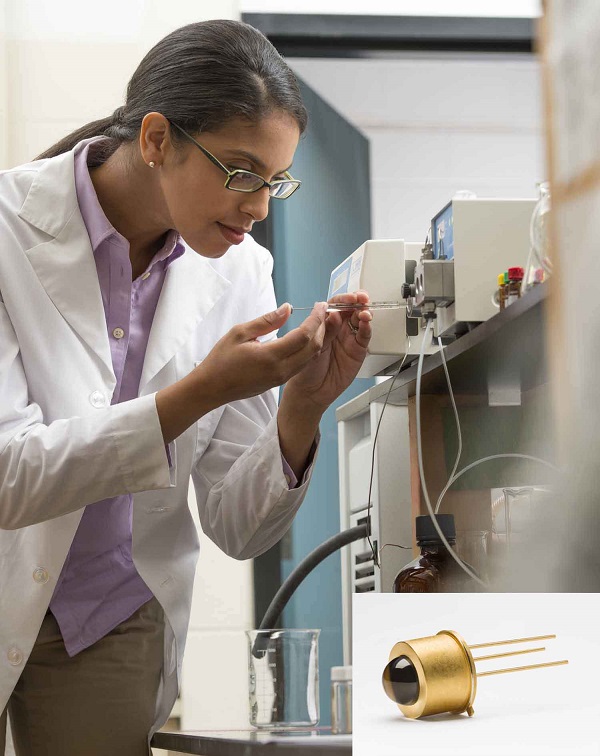
UVC LED 활용 통한 식수 위험 감소(UVC LEDs decrease the footprint for drinking water)
전 세계에서 6억6천만 명은 깨끗한 식수의 접근이 어려운 상황으로 인구 증가 및 사용 가능한 수자원이 축소됨에 따라 상황은 점차 악화되고 있으며, 이러한 문제로 인해 식수에 대한 살균기술의 개발은 더욱 중요해졌다. 특히, UVC(Ultra-violet C) 자외선 파장을 이용한 LED(light emitting diodes) 램프의 성능 개선으로 POU(point-of-use) 장치에서 식수 요구 수준을 만족하는 결과가 나타나면서 이에 대한 관심은 더욱 증가되고 있다.
UVC LED는 기존 저압수은램프와 비교해 더욱 효과적인 살균기능을 제공하는 자외선 파장 램프로 디자인 선택이 다양화되어 최적화된 장치개발이 가능하며, 사용자 측면에서도 상당한 비용절감 효과가 있다. 때문에 UVC LED는 가정용, 사무실용 기기부터 수처리용의 상업화된 대규모 장치까지 모든 적용 분야에 적합한 디자인으로 구성이 가능하다.
More than 660 million people lack access to clean drinking water. This intensifying problem due to growing population and shrinking water tables is driving innovation in drinking water disinfection systems, and the momentum is increasing as improvements in the performance of Ultraviolet C(UVC) light emitting diodes(LED) are matching the requirements of point-of-use(POU) systems.
UVC LEDs provide designers with a more effective germicidal light source; more design flexibility, which leads to more optimized systems; and reduced cost of ownership for the end user. Powerful UVC LEDs are figuring prominently into designs for everything from home and office appliances to commercial systems for water purification.
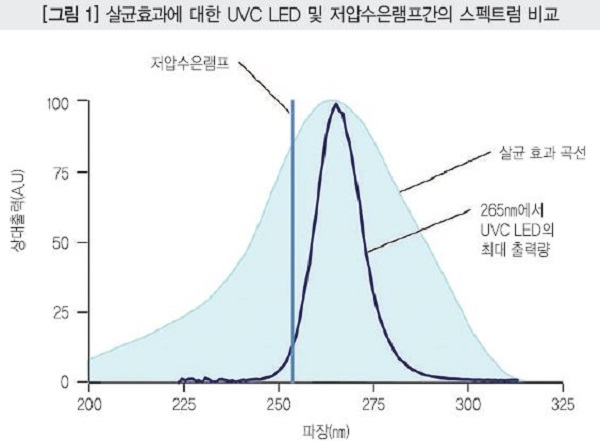
자외선 이용 살균기술에서 250∼280㎚ 범위 파장의 광선은 미생물의 DNA 구조를 파괴해 회복불능 상태로 만든다. 다양한 박테리아·바이러스 균주 중에서 파장의 살균 영향력은 서로 다르지만 일반적으로 박테리아의 살균가능 영역은 265∼275㎚ 범위의 파장으로 보고된다. 전통적으로 POU 시스템에서는 저압의 수은아크램프가 사용되어 왔으며, 살균효과를 갖도록 253.7㎚의 파장을 발산하는 등 이러한 수은램프는 충분한 살균능력을 제공해 현재 산업계의 표준으로 자리잡았다.
UVC LED는 이러한 램프에 비해 디자인 측면에서 장점이 있어 대체용 자외선 램프로 부상하고 있다. UVC LED는 특정 범위 내에서 지속적으로 발산되는 스펙트럼을 가진 입체 회로 소자(solid-state device)이며, LED 등 밴드 폭이 넓은 반도체 부품의 크리스털 성장에 의한 새로운 기술 개발을 통해 발산의 최대 파장은 살균에 적합한 파장으로 함축될 수 있다.
[그림 1]에서 저압수은램프의 발산 파장은 살균효과 커브상의 흡수 최대치보다 낮은 위치에 있음을 보여준다. 이 위치는 살균목적의 적절한 파장 범위는 아니지만 DNA구조 비활성화를 위한 효과는 충분하다고 여겨진다. 그러나 UVC LED의 발산위치는 일반적인 살균효과커브의 파장 대부분과 좁은 간격으로 중복되어 살균용 시스템 적용 시 보다 효율적인 방법으로 평가된다.
In UV disinfection, light in the range of 250 to 280 nanometers(nm) disrupts the DNA of microorganisms, rendering them unable to reproduce. The action spectrum for bacteria is commonly reported as 265 to 275 nm peak wavelengths, although wavelength susceptibility may vary among a large number of bacterial and viral strains.
Traditionally, POU system designers have relied on low-pressure mercury arc lamps, which emit a discrete wavelength at 253.7 nm, to access this germicidal range. These lamps provide sufficient power for the systems and have become the industry standard.
However, UVC LEDs are emerging as an alternative light source because of their design benefits over lamps. UVC LEDs are solid-state devices with a continuous emission spectrum across a specified range. The peak wavelength of the emission may be tailored to germicidal wavelengths with new technology in crystal growth for wide band gap semiconductors such as LEDs[see Figure 1].
Figure 1 shows that the low-pressure mercury lamp emission line intersects the germicidal effectiveness curve below the peak absorption. Although this is not the optimum germicidal wavelength, sufficient emission for DNA inactivation exists. The emission of the UVC LED delivers more overlap of the most critical wavelengths for disinfection, making it a more efficient light source for these systems.
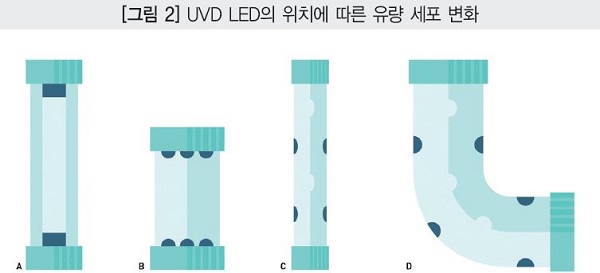

자외선 반응기(UV Reactor)로 일컬어지는 수처리용 유량 세포(flow cell) 설계에서 전체 UV 조사량을 최대로 하고 자외선 조사 범위는 일정하게 분포시켜 UVC 광선이 가장 효율적으로 발산되는 것을 확인할 수 있다. 이로써 제거하고자 하는 미생물은 자외선의 노출범위에서 벗어날 수 없게 된다. 이를 위해 시스템 설계자는 유량 세포의 크기 및 형태, 세포 내 물 흐름 속도, UV 광선 강도 등을 세밀하게 검토해야 한다.
전형적인 살균 시스템에서 반응기 설계는 길이가 길고 원형튜브 구조([그림 2] A 참조)로 된 수은등(mercury bulb)의 형상과 동일하게 이루어진다. 이러한 형상은 반응기 전체의 크기 및 구조 결정에서 선택이 제한되어 전체 UV 장치의 설치 면적에 영향을 준다. 반면, UVC LED는 확장이 가능한 소형 구조로 설계가 가능하며 일정한 점 위주로 반응기 설치면적([그림 2] B, C, D 참조)에 설계 편의성을 부여한다. 또한 크기가 작은 UV 반응기 설계로 소규모의 POU 살균장치 제작이 가능하며, 외부환경의 영향을 최소화함으로써 보다 효율적인 반응기 제작을 위한 현장 일체감을 줄 수 있다.
추가적으로 설치공간이 제한되거나 살균효율을 증대시키려는 경우, 시스템 설계자는 높은 반사 능력을 가진 내부 표면을 이용해 반응기 설계 시 현장에서 일관성을 최적화할 수 있다. 이러한 설계로 다중의 내부 반사 기능을 가진 광자(photons)는 살균 조사량의 점진적인 누적이 가능하도록 재순환된다. UV 반응기의 일반적인 재질은 스테인리스 스틸로서 UV 광선의 28∼33%의 반사효율을 가지나, PTFE 재질은 UVC 파장범위에서 90% 이상의 반사효율을 보여 기존 반응기보다 3배의 효율을 제공한다.
Optimum design of a water purification flow cell - the so-called UV Reactor - ensures UVC light is delivered in the most efficient and effective manner by maximizing overall UV dosage and delivering uniform light distribution so that no target microbes escape exposure. To achieve this, system designers consider flow cell size and shape, water flow rate in the cell, and the system’s UV power.
With traditional disinfection systems, the reactor design must adapt to the shape of a mercury bulb, which is a long, cylindrical tube[Figure 2A]. This shape dictates the footprint of the UV unit in the water system, limiting the system designer’s options for overall size and configuration of the reactor. Conversely, UVC LEDs are a point light source in a durable, compact package, which creates an opportunity for maximum design freedom regarding the reactor footprint[ee Figure 2B, C and D]. The small size of the UV source enables smaller POU disinfection systems and the flexibility to address the maximum fluence rate and field uniformity to produce ever more efficient reactors.
Additionally, in applications where space is at a premium or increased efficiency is needed, system designers can optimize the field of uniformity by leveraging reactor designs with highly reflective inner surfaces. With this design, photons experiencing multiple internal reflections are recycled to contribute to the cumulative disinfection dosage. The most common material in traditional UV reactors has been stainless steel, which only has 28 to 33 percent reflectance of UV light. Alternatives include expanded polytetrafluorethylen(PTFE), which provides more than 90 percent reflectance in the UVC range or almost three times more effectiveness than traditional reactors.
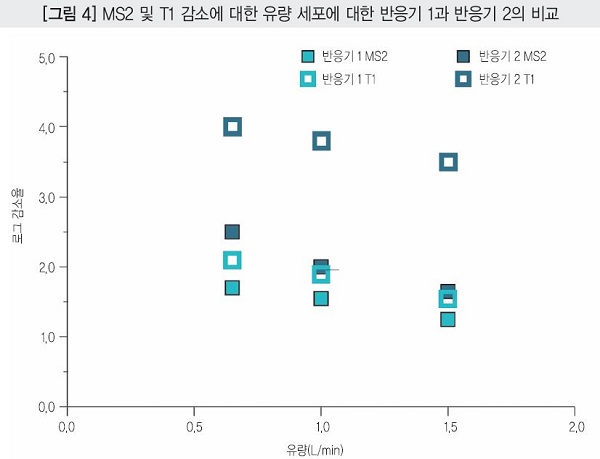
UV 반응기 설계 시 고려되어야 할 핵심 사항은 NSF 인터내셔널(NSF International) 등 표준기관에서 규정한 박테리아, 바이러스 및 원생동물에 대한 조사량 가이드라인에 일치되도록 충분한 살균능력을 제공해야 한다는 점이다. 대부분의 설계자들은 가이드라인에 수립된 평균조사량만을 목표로 한다. 그러나 UV 강도를 최대로 하는 동시에 필요 조사량에 일치하는 UV 광선의 미생물 노출 시간은 최대로 하고, UV 광선에 의한 영향의 동질성에 대해 이해가 필요하다.
일반적으로 살균조사량은 UV 강도에 노출시간을 곱해 산출되므로 살균능력(germicidal power)을 우선적으로 검토해야 한다. 살균조사량 공식에서 노출시간의 계산은 보다 많은 해석, 모델링·설계 검토가 필요하다. 유량 세포 설계 시 물이 반응기 내부에 머무는 평균시간을 나타내는 접촉시간(residence time)이 언급되기도 하는데, 접촉시간이 길수록 살균용 UV 광선에 보다 많은 미생물이 조사 노출될 수 있는 기회가 생긴다.
The primary concern when designing UV reactors is sufficient disinfection to meet well-established dosage guidelines for bacteria, viruses and protozoa from standards committees, such as NSF International. Many designers are simply targeting an average dosage established by these guidelines to create an effective system. Generally, this requires an understanding of the uniformity of UV fluence as well as maximizing UV power and exposure time of microbes to UV light to meet a required dosage.
Overall, a designer first considers germicidal power in the reactor as disinfection dosage is calculated as UV intensity multiplied by exposure time. The second parameter, exposure time from the dosage equation, can require more interpretation, modeling and design. Flow cell designers often refer to the term as “residence time,” which is the average time water spends in the reactor. The longer the residence time, the more microbes have a chance to be irradiated by germicidal UV light.
[그림 4]는 동일한 살균 UV 능력을 가졌으나 물의 살균 시스템에서 반응기 설계가 다른 반응기 두 종류에 대한 비교이다. 시스템은 모두 동일한 양의 물을 처리하고 동일한 시스템 크기를 가졌을 뿐만 아니라 동일한 UVC LED 배열로 되어 있다. 이는 고정된 상태에서 접촉시간을 최대로 하기 위해 물의 유입구 및 배출구의 위치를 변경하는 방법으로 설계되었으며 물의 최대 유속은 1.5L/분으로 동일하다. 반응기 1의 접촉시간은 3.09초, 반응기 2의 접촉시간은 3.76초로 차이가 나타났다. 또한 유량(flow rate)의 3가지 변화를 통해 90%의 UV 투과율 및 100%의 단일 전력 입력 상태에서 반응기 효율에 대한 여러 가지 검사를 실시했다.
수처리 시스템 설계에서 일반적으로 사용되는 유기물질(challenge organism)인 MS2 및 T1 콜리파지(coliphage)로 시딩(seeding)해 유입수로 사용했으며 로그 감소율(log reduction)을 결정하기 위한 목적으로 유입·배출수에 존재하는 미생물(challenge microes)의 농도측정에 대한 검사가 이루어졌다.
[그림 4]는 각각의 반응기에서 MS2 및 T1 미생물에 대해 유속에 따른 로그 감소율의 차이를 나타낸 것이다. 이는 특정 유속조건에서 반응기 2의 긴 체류시간(residence time)이 MS2 및 T1 미생물의 비활성화에 더욱 효과적으로 작용함을 나타낸다.
The example below compares two reactors for water disinfection with identical germicidal UV power but varied reactor design. Both systems process the same amount of water, have the same overall dimensions and have the same UVC LED arrangements. While these variables remained fixed, the designs were altered to maximize the residence time by shifting the position of the water inlet and outlet. For both reactors, the maximum flow rate is 1.5 liters per minute. Reactor 1 has a residence time of 3.09 seconds, while Reactor 2 has a residence time of 3.76 seconds.
A series of tests evaluated the efficacy of the reactors at three flow rates with a UV transmittance of 90 percent and a single power input of 100 percent. The influent was seeded with MS2 and T1 coliphage, which are common challenge organisms used in water system designs. The tests measured the concentrations of the challenge microbes present in the influent and effluent to determine the log reduction. Figure 4 shows the difference in log reduction at varied flow rates for microbes MS2 and T1 in each reactor. Simply put, the longer residence time of Reactor 2 at a given flow rate results in a more effective inactivation of the MS2 and T1.
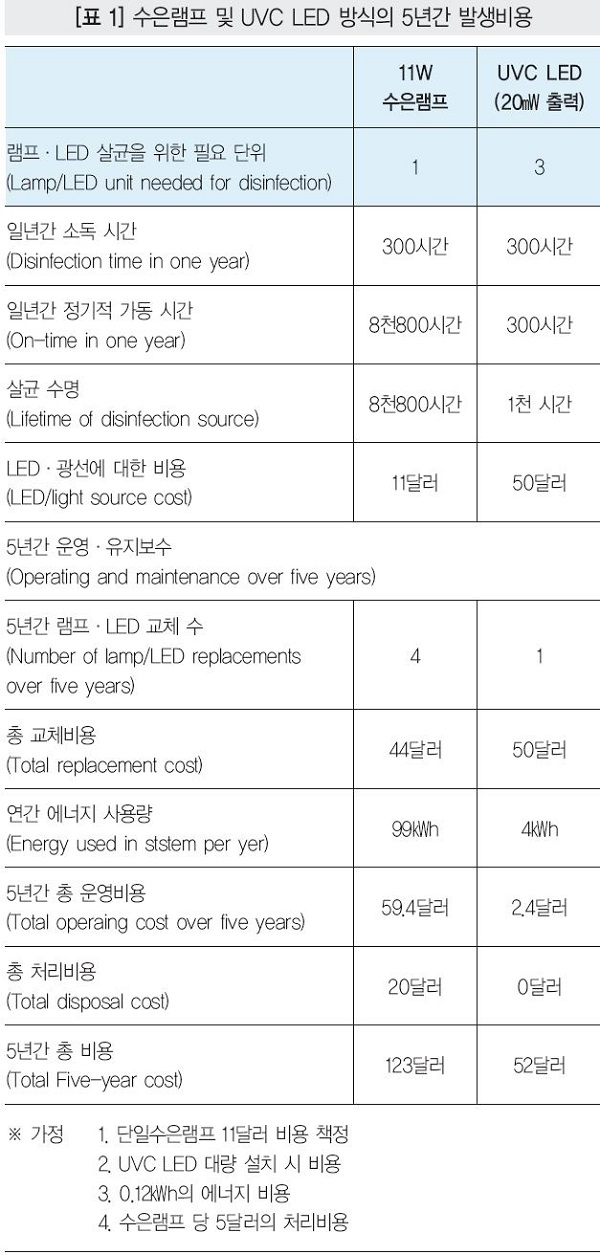
사용자 입장에서 비용절감은 POU 장치에서 핵심적인 제품의 차별성을 제공한다. 전통적인 수은램프는 필요한 살균강도 효과를 얻기 위해 50초에서 10분까지 다양하고 긴 초기시간(warmup time)을 요구하며, 잦은 가동·중단 사이클(on/off cycle) 운전으로 인해 사용수명은 50% 이상 감소될 수 있다. 때문에 수은램프는 하루 종일 켜져 있어야 하므로 램프 교체주기가 잦고 전력소비가 증가하는 이유가 된다.
반면, UVC LED의 경우 순간적인 가동·중단 운전기능이 있어 살균이 필요한 때에만 가동되어 전력 소모량을 감소시킬 수 있다. 또한 잦은 가동·중단 사이클 운전으로도 LED 수명이 감소되지 않아 운전 및 유지보수 비용을 절감할 수 있는 한편, 유해한 수은 물질 처리와 관련된 문제점이 LED에서 발생하지 않는다. 이와 관련해 [표 1]은 수은램프 방식 및 UVC LED 방식의 5년간 발생비용에 대한 분석을 나타냈다.
UVC LED의 탁월한 성능으로 제조사들은 수은램프에서 고체 상태의 광선 솔루션(lighting solutions)으로 변환·적용이 가능해졌다. 이에 UVC LED는 살균용 파장에 의한 높은 효율과 세밀한 구조로 식수처리에서 보다 효과적인 살균장치로 부상했다.
수처리 및 공기 중의 살균효과가 99.99% 이상으로 나타나고 있음에도 UVC 광선이 기존 방법의 필수적 대체기술이 될 수 있는지, 또는 새롭고 혁신적인 디자인으로 UVC 기술이 넓은 범위에서 지속적으로 사용될 수 있는지에 대한 약간의 의문점은 있다. 그러나 5년간 수명에 대한 57%의 비용절감효과는 사용자들이 UVC 기술을 선택하는 데 주저하지 않을 것임을 시사한다.
Reducing cost of ownership offers a key product differentiator in POU systems. Traditional mercury lamps require a long warm up time, anywhere from 50 seconds to 10 minutes, to reach the required germicidal intensity. In addition, frequent on/off cycles can diminish lifetime by 50 percent or more. Consequently, mercury lamps in these applications are often kept on all day, increasing the frequency of lamp replacement and power consumption.
By contrast, the instant on-off capability of UVC LEDs enables on-demand disinfection, which reduces power consumption. Additionally, the frequent on/off cycles do not diminish LED lifetime, helping lower operating and maintenance costs. Finally, no concern for disposal of hazardous mercury comes with LEDs, addressing another element of lifecycle cost. Table 1 provides a five-year cost analysis for the mercury lamp-based and UVC LED-based systems.
High performance UVC LEDs are allowing manufacturers to migrate from mercury lamps to solid-state lighting solutions. The higher efficiency in the germicidal wavelengths and compact footprint of UVC LEDs enable more effective disinfection systems for safe drinking water. With demonstrated effectiveness in water and air disinfection for more than 99.99 percent of germicidal efficacies, little question remains that these light sources are a viable alternative to traditional methods and will continue to trend in innovative new designs. With lifetime cost savings of 57 percent over five years, consumers are sure to adopt it.
[『워터저널』 2016년 6월호에 게재]

